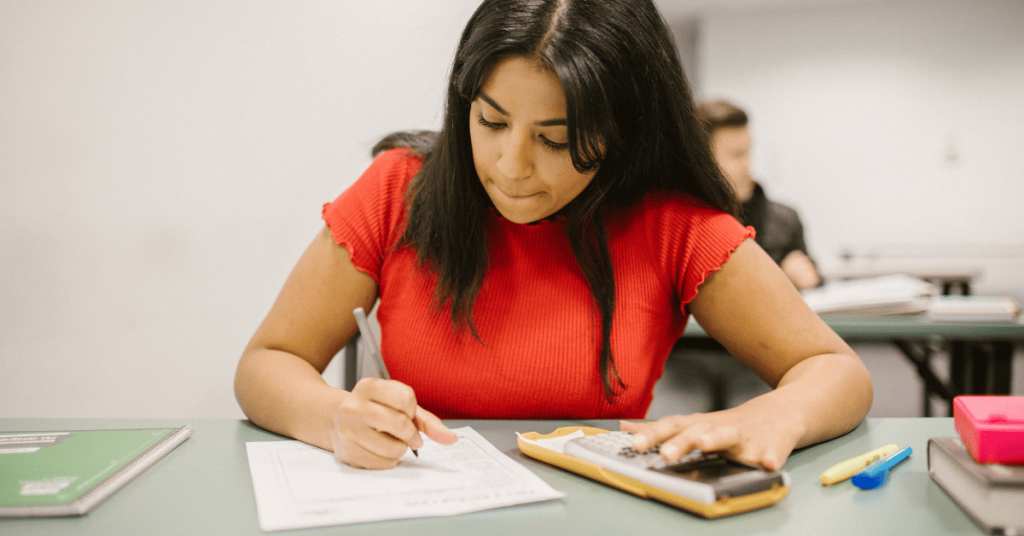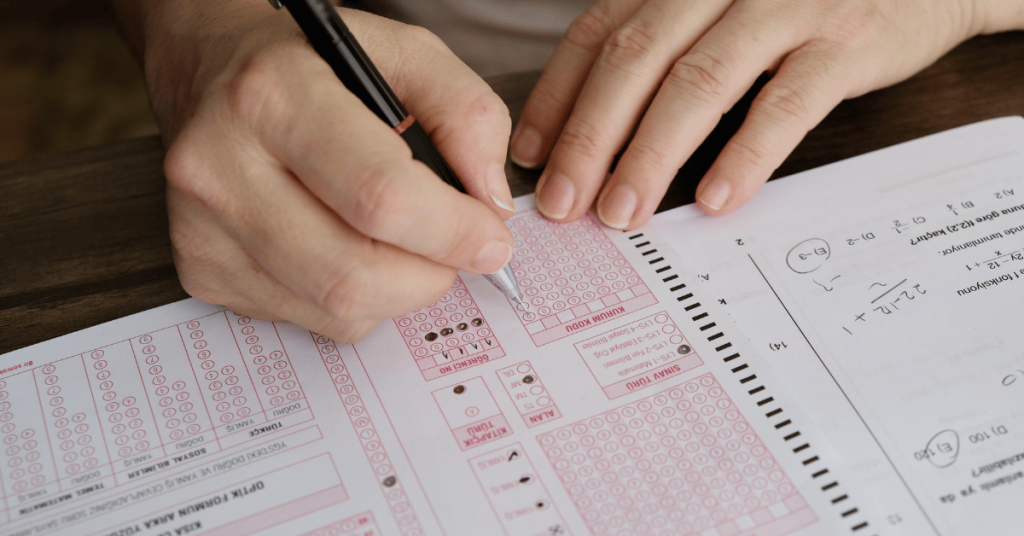The Scholastic Assessment Test, or SAT, is frequently used in the US to determine college admission. It evaluates a student’s knowledge and abilities in arithmetic, reading, and writing and gives colleges a precise idea of that student’s academic prowess.
It’s critical to comprehend the SAT’s format, organisation, and scoring system if you intend to take the test in 2023.
This guide will provide a thorough understanding of the SAT exam along with SAT syllabus, including information on its background, format, sections, scoring, and success strategies.
Structure of the SAT Exam

The SAT exam’s full form stands for Scholastic Assessment Test which comprises four primary parts: Reading, Writing, and Linguistics, Math (with a calculator), and Math (without a calculator). The test additionally features an elective Essay section. The complete examination duration is 3 hours and 50 minutes, which includes the Essay section.
1. The Reading Part
The Reading part comprises five reading passages with 52 multiple-choice questions. The passages are diverse in subject matter, ranging from social studies to literature and science. The section evaluates students’ aptitude to understand, construe, and scrutinise written content.
2. The Writing and Language Category
The Writing and Language category comprises 44 questions in a multiple-choice format that evaluate a student’s capability to recognize and rectify grammatical, punctuation, and sentence structure errors. Additionally, the category gauges a student’s proficiency in enhancing the transparency and efficiency of written material.
3. The Maths Categories
The Math categories include 58 multiple-choice questions and 15 grid-in questions, with 25% being non-calculator based. The categories include a variety of maths topics like algebra, geometry, and trigonometry. The questions evaluate students’ ability to deduce mathematically, solve problems, and employ mathematical concepts.
4. The Optional Essay Section
The Essay section is optional, including one prompt requiring students to scrutinize and assess an argument. The students get 50 minutes to finish the essay.
Exam Pattern and Timing

At test locations worldwide, the SAT exam is given several times throughout the year. Three hours and 50 minutes is the overall test time, including the optional essay. Following is a breakdown of the time allotted and the questions for each section:
- Reading: 65 minutes for 52 questions
- Language and Writing: 35 minutes for 44 questions
- Maths (with a calculator): 55 minutes for 38 questions (including 8 grid-in questions)
- Maths (without a calculator): 25 minutes for 20 questions (including 5 grid-in questions)
- Optional Essay: 50 minutes for one essay prompt
- A 10-minute break is allowed after the Reading part, and a 5-minute break is allowed after the test’s Math (no calculator) segment.
Scoring System and Interpretation

With distinct scores for the Reading, Writing, Language, and Math components, the SAT is graded from 400 to 1600. The Essay portion gets a different grade on a scale from 2 to 8. There is no deduction for wrong answers; instead, scores depend on the proportion of accurate responses.
Students also earn subscores for each segment, which offer more details about their performance in particular areas and their overall raw score. Command of Evidence, Words in Context, and Analysis in History/Social Studies and Science, for instance, are subscores for the Reading portion.
To assist students in understanding their scores, the College Board also offers a variety of percentiles. Percentiles show the proportion of test-takers who scored lower than a student by comparing their score to those of other test-takers. For example, a percentile score of 75 signifies that the student scored above 75% of all test-takers.
What all are included in these Exam Sections: Detailed

The four areas of the SAT exam include Math, Reading, Writing and Language, and an optional Essay section. Each segment assesses a separate set of competencies necessary for academic achievement in college. We will go into detail about each section in this part.
1. Reading Section
The SAT’s Reading section has 52 multiple-choice questions and takes 65 minutes to complete. The component assesses a student’s capacity to comprehend and critically evaluate challenging passages in fiction and non-fiction. Science, history, social studies, and literature are just a few topics covered in the sections.
Types of Questions and Passages
Five texts of 500–750 words each make up the reading section. The passages follow 10–11 questions pertinent to the passage’s subject matter. Students may:
- Identify the passage’s central point or subject.
- Examine the author’s viewpoint or argument.
- Interpret rhetorical devices or metaphorical language.
- Specify any details or arguments.
- Compare and contrast the passage’s various sections.
- Explain or paraphrase what is in the passage.
Advice and Techniques for Success
To succeed in the Reading section, students should:
- Read the sections attentively and actively, focusing on the author’s key points, supporting details, and tone.
- Answer the questions using the passage’s evidence rather than your beliefs or biases.
- They properly manage their time by pacing themselves to complete all the questions in the allowed time.
- To understand the meanings of unknown words or phrases, consider the context.
- Learn to read and analyse challenging sections from various publications, including books, newspapers, and periodicals.
2. Writing and Language Sections
The SAT exam’s Writing and Language section has 44 multiple-choice questions and takes 35 minutes to complete. A student’s ability to edit and improve written passages—correcting grammar, punctuation, and sentence structure—is evaluated in this area.
Various Types of Questions
The four passages in the writing and language part are between 400 and 450 words long. The passages follow 11 questions pertinent to the passage’s subject matter. Students may:
- Recognize and fix grammatical, punctuation, and sentence structure mistakes.
- Enhance the passage’s order and clarity.
- Find the most appropriate phrase or word to use in place of the highlighted text.
Advice and Techniques for Success
To succeed in the Writing and Language section, students should:
- Examine the writing’s clarity, structure, and coherence as you attentively and actively read the passages.
- Use their proficiency with language and punctuation to spot and fix mistakes in the passage.
- Identify the passage’s significant concepts and additional details to make the text more coherent and clear.
- To understand the meanings of unknown words or phrases, consider the context.
- Practice writing and editing essays, research papers, and other written pieces.
3. Mathematics Section
The SAT exam’s Mathematics section has two parts: one that allows calculator use and the other that does not. The portion assesses a student’s aptitude for dealing with algebra, geometry, trigonometry, and data analysis problems.
Topics and Question Types Covered
There are 58 multiple-choice questions in the 80-minute Mathematics section. Students may:
- Use algebraic expressions and equations to solve problems.
- Identify and resolve issues with geometrical elements and measurements.
- Apply advanced algebra and trigonometry principles.
- Data and statistics interpretation and analysis.
- Thirty questions in the segment allow calculators, compared to 28 in the section that does not.
Advice and Techniques for Success
To succeed in the Mathematics section, students should:
- Recognize the ideas and formulae tested, such as trigonometry, geometrical figures, algebraic equations, and data analysis.
- Use their calculator wisely, but be ready to solve problems without it during the section where calculators are prohibited.
- Display their work and validate the accuracy of their responses.
- To solve complex problems, find patterns and linkages and use them.
- Work on your arithmetic problem-solving skills by taking timed practice exams and drills.
4. Optional Essay Section
The 50-minute optional essay portion of the SAT consists of a single essay prompt. The component evaluates students’ capacity to research and write about subjects.
Importance and Purpose of the Essay Section
Even though it is an optional application component, many colleges and institutions require it or strongly suggest it. This part evaluates a student’s capacity for:
- Analyse a problematic argument or problem
- Create and support a thesis statement that is concise and well-structured.
- Use examples and proof to back up your points.
- Effective and comprehensible writing requires the use of proper grammar and syntax.
Advice and Techniques for Success
To succeed in the Essay section, students should:
- Examine the essay prompt attentively to discover the essential components and assignment criteria.
- Create a thesis statement that directly responds to the prompt.
- Use precise details and proof to back up your points and your thesis.
- Utilize efficient paragraph transitions that are both logical and transparent to the reader.
- They should thoroughly check their essay for spelling, punctuation, and grammar mistakes.
Here Are Some Test Preparation Resources

Success on the SAT exam depends on test preparation. The numerous sat exam syllabus and test preparation resources that are accessible are listed below:
- Official practice sessions for SAT exams are available from the College Board, which oversees the SAT exam. Students can take these examinations to get ready for the real thing. These exams can give students a solid idea of what to expect on test day because they closely resemble the actual SAT exam in both format and substance.
- In addition to practice exams and activities to help students refine their skills, several test preparation books provide tactics and suggestions for success on the SAT exam.
- The SAT exam preparation tools, which include practice exams, exercises, and videos, are available from several websites and online resources.
- Many students work with a tutor or sign up for a test prep course to gain more individualised instruction and support in their test preparation.
Crucial Tips for Performing Well on Your Test Day

Students may suffer anxiety and worry on SAT exam days. Still, with enough planning and understanding of test day protocols, students can reduce anxiety and ensure a stress-free testing experience.
Pre-Test Day Preparations
Students should take precautions the day before the SAT exam to ensure they are physically and emotionally ready for the big day. Preparations for the day of the test comprise the following:
- To be fully rested and alert on exam day, ensure you get a full night’s sleep the night preceding the test.
- To ensure you are familiar with what will happen on the day of the SAT exam, meticulously read the instructions and regulations provided by the College Board.
- By planning your journey beforehand, ensure you are well-informed on getting to the testing centre.
- On the test day, gather all the necessary supplies, such as your admission ticket, identification, an approved calculator, and other essential items.
Test Day Schedule and Procedures
It is vital to adhere to the College Board’s guidelines and arrive well-prepared at the testing location on exam day. What can be expected is outlined below:
- Check-in: When arriving at the testing location, students must check in and present their ID and admission ticket.
- Instructions: Students will be given directions on the test format, including time management, break schedules, and rules and regulations.
- Test: The exam will begin promptly at the designated start time, and each test section will have a specific duration for completion.
- Breaks: Scheduled breaks are included in the test day schedule, such as a 10-minute break following the Reading section and a 5-minute break after the Math No-Calculator portion.
- Completion: After the test, pupils are dismissed and allowed to exit the testing facility.
What to Bring and What not to Bring
It’s crucial to carry the required supplies and avoid bringing any forbidden items if you want your SAT exam day to go successfully. What to bring and what not to bring on exam day are listed below:
What to Pack
- To the testing site, students must carry their printed admission ticket.
- A legitimate, government-issued photo ID is necessary to carry for students.
- Students can use a calculator on the exam, although only particular types are permitted. The College Board website has a list of approved calculators you can consult.
- The SAT exam requires two No. 2 pencils, so take at least two to ensure you have a backup.
- Bring some snacks and drink to the test to stay energised between breaks.
What not to Pack
- Cell phones, smartwatches, and other electronic devices are prohibited in the testing room.
- Keep books, notes, or study materials out of the testing area.
- In addition, rulers, pens, coloured pencils, and highlighters are not allowed.
Scoring and Score Reporting

The Reading, Writing, Language, and Math portions of the SAT are given distinct scores on a scale of 400 to 1600. Additionally, an optional essay portion receives its scoring on a scale from 2 to 8. Approximately two weeks following the test date, results are typically made public.
Students can access their College Board accounts to view their scores online. Students can send their test results directly to schools and universities through their College Board accounts. The College Board offers resources to assist students in analysing their exam results and comprehending how they stack up against other test-takers.
Final Thoughts

The SAT exam is a crucial component of the college application process, and students can succeed on the test with the appropriate planning and approach. Students can improve their scores and chances of getting into their desired colleges by taking advantage of available resources, SAT exam syllabus, adhering to best practices for test preparation, and remaining calm and focused on test day.


Frequently Asked Questions
What is the SAT exam format?
The SAT exam consists of two sections, Math and Evidence-based Reading and Writing, each scored out of 800. There is also an optional essay section.
What is the SAT syllabus?
The SAT syllabus covers math, reading, and writing skills required for college-level coursework. It includes algebra, geometry, grammar, and vocabulary.
How long is the SAT exam?
The SAT exam is 3 hours long, with an additional 50 minutes for the optional essay. If taking the SAT with Essay, the total test time is 3 hours and 50 minutes.





Comments (0)